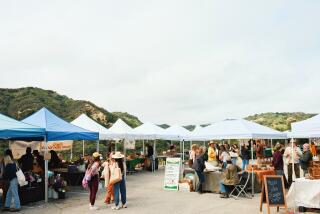Market Watch: Atwater Village market’s local tomato grower, Cameron Slocum
Cameron Slocum pulls up to the Atwater Village farmers market in the Tomatomobile, a 1980s Volvo station wagon with crude icons of tomatoes, blue on the right side, pink on the left, scrawled everywhere including the windows, along with a plug for “The Eastside Tomato King.com.” He whips out a high-design Italian chair and a few handfuls of carrots, radishes and beets, which he displays on a table covered with trippy spirals. “Dad approaches everything like a visual arts project,” says his daughter and assistant, Lina, 19. “Last year when he sold at farmers markets it was more a performance piece than anything else.”
Slocum is certainly not your average farmers market vendor. He combines self-promotion and elusiveness, to the extent that some have even suspected that his tomato farm is an urban legend. But as a recent visit revealed, he does in fact grow tomatoes, and this week he’ll be selling them for the first time at farmers markets, at the Silver Lake and Atwater Village venues.
Photo gallery: David Karp captures what’s fresh at the farmers market, and more.
Born in Glendale in 1957, he started a performance art space when he attended UC- San Diego, then forged a career as a fine arts photographer, sculptor and painter, exhibiting at galleries in Europe and the United States. With the profits from a successful show in 1986 he bought his current home in Lincoln Heights, northeast of downtown Los Angeles. In addition to creating art, he sold modern furniture from 1985 to 2005, until EBay killed his business, he says.
For years he grew a few tomatoes in a garden in his half-acre backyard, but it was just in the last few years, as other sources of income dried up, that he expanded his planting into what he calls Cam’s Farm.
“I did it on a bet,” he says. “A friend named Fred who later died said I couldn’t pull it off. But in 2008 I gave all the tomatoes away, because I felt like it would be disrespectful to the memory of Fred to sell them.”
Last winter he grew mâche, and now he has radishes, carrots and his namesake crop, several thousand tomato plants of a full-flavored dark-pink beefsteak heirloom variety called Mexico.
Up a set of stadium stairs from the street, his bungalow is strewn with dishes, ashtrays, art supplies and the art itself, spooky, spectral images on marble and paper. The stairs carved into the hillside leading up to the tomatoes are still a work in progress, and the slope vertiginously steep, enough to intimidate most creatures other than goats or llamas. But as one ascends to the top of his property, there’s a sweeping view of the Eastside, downtown and the Hollywood Hills.
“I feel like I’m farming in the Andes,” Slocum says, waving an omnipresent Camel 99 cigarette. “I’m going to put in a funicular so that I can continue farming when I get older.”
Farther up the hill a small grove of walnut trees and the scraggly remnants of old grapevines cling to the slopes, a relic of the era, before the Second World War, when Los Angeles was the most productive farm county in the nation, and vineyards abounded in the Southland. Slocum has grand hopes that the profits from selling his tomatoes will allow him to buy adjacent properties and substantially expand his plantings. “Just a few acres though,” he says. “If I take it bigger than that I lose all control.”
There are many parts of California and the nation where all farmers markets vendors grow locally. Los Angeles is not among them, obviously, although there are a few exceptions, mostly postage stamps of agriculture located beneath power lines. Slocum prides himself on what he calls “hyperlocal production,” and sells at the nearby El Sereno farmers market. His original idea was to sell no further than five miles distant, but if his harvest goes well, he’s considering venturing farther afield to other farmers markets.
Slocum writes a blog with excerpts from what he says will be a forthcoming book entitled “Seeing Red: Confessions of the Eastside Tomato King,” with contents ranging from self-portraits and farm photos to a recent profane rant against the gophers assailing his plants. He says he’ll soon be opening an art gallery in his home. Unsurprisingly, he adds that he is in the “early stages of negotiations with a producer for a reality television show.”
All this and tomatoes too? Hard to believe, even for a guy who says he works 17 hours a day. But chefs who have bought Slocum’s produce speak well of him. “We have indeed purchased green tomatoes from Cam,” wrote Corina Weibel, chef-owner of Canelé in Atwater Village, in a recent e-mail. “We pickle them and feature them on our fried chicken sandwich at brunch. A big hit. I’m sure we’ll be purchasing more from him in the future. He’s quite a character!”
***
Another mysterious grower whose farm sits high on a hillside, in this case overlooking the San Gabriel Valley, is Jerry Dimitman, who turns 90 this month. A retired professor of plant pathology from Cal Poly Pomona, he has planted a famous collection of lychee, longan, wampi and pummelo trees, many of them huge, mature specimens of rare varieties. He sells the fruits, with the aid of his children, at the Alhambra farmers market, where the mostly Asian American customers form long lines, appreciative of the freshness of his offerings.
Last week he started bringing lychees, with bright red shells and juicy, sweet-tart flesh. Lychees are one of the most emblematic fruits of southern China, where they are grown in vast quantities and exported to the United States from May to July; these often are sold cheaply, undercutting producers in Florida and Mexico, who have objected that most of the Chinese fruits are treated with sulfur dioxide gas, which maintains the rosy color and soft texture of lychee skins during shipping. As is so often the case with long-stored fruits, however, the pristine appearance of treated lychees long outlasts optimal flavor.
Because the climate in California differs considerably from that of southern China, lychee trees flower and fruit undependably here, making commercial cultivation impractical, even though there is limited competition at this time of year. But for those who love luscious, fresh, untreated lychees, the local season runs for the next few weeks. In addition to Dimitman, Steve and Robin Smith of Mud Creek Ranch in Santa Paula have started selling organically grown lychees at the Santa Monica Wednesday and Hollywood farmers markets.
food@latimes.com
More to Read
Eat your way across L.A.
Get our weekly Tasting Notes newsletter for reviews, news and more.
You may occasionally receive promotional content from the Los Angeles Times.






